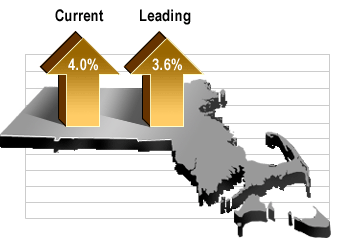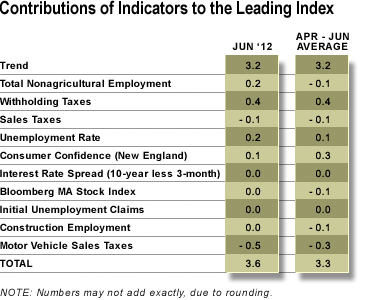State Growth Continues to Outpace Nation in Q2, UMass Journal Reports
June 2012
 The growth in Massachusetts real gross state product increased at a 4.0 percent annualized rate in the second quarter of this year according to the latest Current Economic Index released today by MassBenchmarks, the journal of the Massachusetts economy published by the UMass Donahue Institute in collaboration with the Federal Reserve Bank of Boston.
The growth in Massachusetts real gross state product increased at a 4.0 percent annualized rate in the second quarter of this year according to the latest Current Economic Index released today by MassBenchmarks, the journal of the Massachusetts economy published by the UMass Donahue Institute in collaboration with the Federal Reserve Bank of Boston.
In contrast, the growth in US real gross domestic product increased at a 1.5 percent annualized rate during the same period according to the Advance Estimate released earlier today by the US Bureau of Economic Analysis. In the first quarter of 2012, the Massachusetts economy grew at an estimated 4.0 percent rate as compared to 2.0 percent for the U.S. On June 5th the BEA estimated that the state's economic output grew at a 2.2 percent annual rate in 2011, making Massachusetts the seventh fastest growing state in the nation last year.
The MassBenchmarks Leading Economic Index for June was 3.6 percent, and the three-month average for April through June was 3.3 percent. The leading index is a forecast of the growth in the current index over the next six months, expressed at an annual rate. Thus, it indicates that the state economy is expected to grow at an annualized rate of 3.6 percent over the next six months (through December 2012).
 The state's labor market continued to strengthen in the second quarter albeit at a slower pace than in the first. The unemployment rate fell one-half a percentage point during the quarter, from 6.5 percent in March to 6.0 percent in June while the U.S. unemployment rate ended the quarter where it began, at 8.2 percent.
The state's labor market continued to strengthen in the second quarter albeit at a slower pace than in the first. The unemployment rate fell one-half a percentage point during the quarter, from 6.5 percent in March to 6.0 percent in June while the U.S. unemployment rate ended the quarter where it began, at 8.2 percent.
Long-term unemployment and underemployment continue to be major challenges for the Commonwealth and the nation. In June, the broader U6 measure of unemployment (which includes discouraged and marginally attached workers, and those working part-time because they can't find full-time work) was 12.2 percent in Massachusetts and 14.9 percent nationally.
State payroll employment growth slowed to a 1.4 percent annual rate in the second quarter after growing at a 2.7 percent rate in the first quarter, according to the official payroll survey of employers. U.S. payroll employment growth also slowed, to 1.0 percent in the second quarter from 2.1 percent in the first quarter.
As we have discussed previously, these employment data are subject to revision and should be interpreted cautiously. However, tax collection data are consistent with employment growth. Withholding tax collections suggest that state wage and salary income surged at a 14.8 percent annual rate in the second quarter, after growing at a 7.1 percent rate in the first quarter.
In reality, earnings growth was likely more modest than these figures imply. According to the Massachusetts Department of Revenue (DOR), some of these withholding taxes that would have normally been received in July appeared to have arrived in June. Accounting for DOR's estimate of the impact of these early receipts reduces the estimate of second quarter growth to a very respectable 9.2 percent annual rate.
Consumer spending on items subject to the regular sales tax and motor vehicle sales tax grew at a 6.5 percent annual rate in the second quarter, after falling by a 10.9 percent rate in the first quarter. Between the second quarters of 2011 and 2012, this measure of discretionary consumer spending grew 3.8 percent.
The leading index is projecting a moderate slowdown in state economic growth in the second half of the year, to 3.7 percent in the third quarter and 3.6 percent in the fourth quarter. "There is substantial downside risk to this outlook, due to weakness in Europe, slowing growth in China, weak growth in the U.S. economy, and uncertainty about whether and how the looming "fiscal cliff" coming in 2013 will be resolved." noted Dr. Alan Clayton-Matthews, MassBenchmarks Senior Contributing Editor and Associate Professor of Economics and Public Policy at Northeastern University, who compiles and analyzes the Current and Leading indices.
"One indication of the drag Europe is having on the state's economy is visible in Massachusetts merchandise exports, which are down 1.3 percent in the first five months of this year relative to a year ago. Merchandise exports for the U.S. as a whole, which is less reliant on Europe, are up 6.8 percent over the same period of time." added Martin Romitti, MassBenchmarks Managing Editor and Director of Economic and Public Policy Research at the UMass Donahue Institute.
 The 10 indicators that comprise the leading index usually do not all move in tandem. Typically, some may indicate an expectation of faster than average growth, while at the same time others may indicate an expectation of slower than average growth. The following table accounts for the contributions of each towards faster or slower growth than the long-term trend of 3.2 percent. The index value is their sum.
The 10 indicators that comprise the leading index usually do not all move in tandem. Typically, some may indicate an expectation of faster than average growth, while at the same time others may indicate an expectation of slower than average growth. The following table accounts for the contributions of each towards faster or slower growth than the long-term trend of 3.2 percent. The index value is their sum.
In June, four indicators contributed to a forecast of above-trend growth: total nonagricultural employment, withholding taxes, the unemployment rate, and consumer confidence. Two indicators contributed to below-trend growth: sales taxes, and motor vehicle sales taxes. Four indicators contributed to average-trend growth: the interest rate spread between 10‑year and 3‑month U.S. Treasury securities, the Bloomberg stock index for Massachusetts, initial unemployment claims, and construction employment.
In the three-month period April through June, three indicators contributed to a forecast of above-trend growth: withholding taxes, the unemployment rate, and consumer confidence. Five indicators contributed to below-trend growth: total nonagricultural employment, sales taxes, the Bloomberg stock index for Massachusetts, construction employment, and motor vehicle sales taxes. Two indicators contributed to average-trend growth: the interest rate spread between 10‑year and 3‑month U.S. Treasury securities, and initial unemployment claims.
The current and historical quarterly estimates for state domestic product growth include adjustments for changes in productivity growth. These adjustments are estimates of the quarterly deviations from trend in the growth of the ratio of output to employment and output to wage and salary income. In the second quarter of 2012, these adjustments subtracted 0.4 percentage points from the annual rate of growth. In the first quarter of 2012, these adjustments subtracted 1.2 percentage points from the annual rate of growth. For the forecast of state domestic product growth for the third and fourth quarters of this year, productivity growth is assumed to return to its long-term trend. The methodology and rationale for these adjustments are available from the author upon request.
Several recent months of the indices are revised each release. These revisions are a result of the statistical method used to create the index, as well as revisions in the underlying indicators.
--------
All of the indicators except interest rates refer to Massachusetts. The current index is composed of four indicators: nonagricultural employment, withholding taxes, sales taxes, and the unemployment rate. The leading index includes these four current indicators plus the other six (leading) indicators in the contributions table. All of the indicators are as of June, except for interest rates, and the Bloomberg stock index for Massachusetts, which are through July 19. The MassInsight Consumer Confidence Index is released every third month. Intervening months are interpolated, and changes in the Conference Board's Consumer Confidence Index for the U.S. are used to extrapolate to the current month of the index, as needed. Series measured in dollars, i.e., withholding taxes, sales taxes, the Bloomberg stock index, and motor vehicle sales taxes, are deflated by the U.S. consumer price index for all urban consumers, excluding food and energy.
For a description of the methodology used to construct these indices, see: Alan Clayton-Matthews and James H. Stock, "An application of the Stock/Watson index methodology to the Massachusetts economy", Journal of Economic and Social Measurement, vol. 25 (1998/1999), pp. 183-233.
July 27, 2012
Dr. Alan Clayton-Matthews
Senior Contributing Editor, MassBenchmarks
Associate Professor of Economics & Public Policy
School of Public Policy and Urban Affairs
Northeastern University

